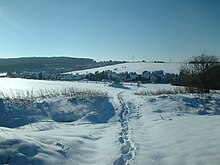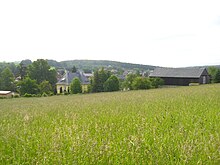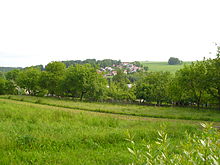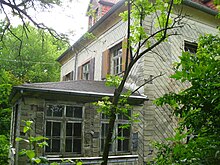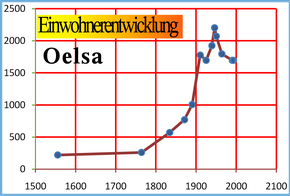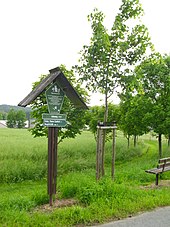Oelsa (Rabenau)
|
Oelsa
City of Rabenau
Coordinates: 50 ° 57 ′ 0 ″ N , 13 ° 40 ′ 0 ″ E
|
|
|---|---|
| Height : | 302 (300-425) m |
| Area : | 6.01 km² |
| Residents : | 1220 (Feb 10, 2015) |
| Population density : | 203 inhabitants / km² |
| Incorporation : | March 1, 1994 |
| Postal code : | 01734 |
| Area code : | 0351 |
|
Location of Oelsa in Rabenau
|
|
Oelsa [ ˈœlzɑː ] is a district of Rabenau in the Saxon district of Saxon Switzerland-Eastern Ore Mountains .
geography
Oelsa is a five-kilometer-long village along the Oelsabach , whose wide Muldental runs in the local area between the ridges of the Lerchenberg, the Steinhübel and the Götzenbüschchens from southeast to northwest. The type of settlement corresponds to a row village , which goes back to a forest hoof village of Slavic origin. The place is about 300 m above sea level on the northern edge of the Dippoldiswalder Heide in the Eastern Ore Mountains. Approx. 1300 inhabitants (2004) live in the Oelsa district.
Neighboring places
| Rabenau | Obernaundorf | |
| Spechtritz |

|
Brooch |
| Seifersdorf | Malter | Karsdorf |
history
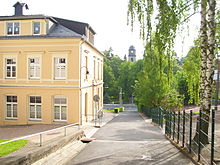
The first written mention under the name Olßen goes back to the year 1443. The alders that can still be found along the course of the brook and to which the Old Sorbian brook name "Olšova" (Eng .: Erlenbach) can be traced back gave the place its name. In 1501, the interest and services of the inhabitants to Rabenau Castle are mentioned, in 1550 the board mill with a grinding course on the Ölsabach, which belonged to the Vorwerk Ölsa, is mentioned for the first time.
In 1624 the Waldhufendorf was divided into Großölsa and Kleinölßa with its 28 farmers . It was not until 1926 that it merged to form the village of Oelsa. The torture column on the outskirts of Neuoelsa, where a hiker died on the Salzstraße (later Kleine Straße) that once passed to Frauenstein and finally the Seifersdorfer Kirchweg, was erected in the 15th century. In 1638 Großölsa local judge 1 Hufengut is named as Wüst, during the Thirty Years War in 1639 Swedish troops set parts of the village on fire.
By the catechist Gottfried Ehrlich from the neighboring parish village Seifersdorf , the first school lessons for the children took place in the houses of the village as early as 1744. The first school was built in 1763 (next to the Meyer bakery on Hauptstrasse) , the second schoolhouse in 1842 ( where it joins Kirchstrasse on Hauptstrasse) and replaced in 1902 by another new school building (at the cemetery) . The enlarged Oelsa school serves as a state primary school for the municipality of Rabenau and all of its districts. As the first own school teacher, ELLeuschner taught in the school of Oelsa from 1837, which was followed in 1841 by Carl August Pöge.
In 1813, during the Napoleonic War, the French quartered themselves on their way to Dresden in the Güterut, lived very wildly, although the rest of the town was probably not spared either. The place was characterized by the straw weaving trade, so in 1837, four weavers are counted in Kleinölsa and 36 in Großölsa. At the end of the 19th century, less good soil values led to the development of trade and handicrafts and a strong timber industry alongside agriculture . A few small farms became businesses and workshops for the chair industry and wood processing . As early as 1913, there were six chair factories in the village, in addition to the local farmers who made their chairs as a sideline. The largest factory was that of the Ernst Wolf company, which was founded in 1895, has been referred to as Ernst Wolf & Co since 1903 and was expanded by his heirs from 1911 to 1913.
In 1922 a volunteer fire brigade was founded as the “fire extinguishing association of the community Groß- und Kleinoelsa”. Since 2003 it has been a district brigade of the fire brigade of the city of Rabenau. The old syringe house of Großoelsa was built in 1844, in 1927 a new syringe house with riser tower was built. The cemetery was opened in 1900, the parish of Oelsa was founded in 1913, and in 1921 three new bells were consecrated in a free-standing bell tower and in the school. After the sale of the Baumgartschen Hof on September 2, 1927, the demolition in 1925 and 1933 next to the church , it was consecrated on the 1st of Advent 1928 and belongs to the Evangelical Lutheran Church of Saxony . The parish belongs to the parish Kreischa -Seifersdorf with the parishes Kreischa, Oelsa, Possendorf, Rabenau and Seifersdorf. Pastors for all five parishes are, Pastor Maria-Theresia Rentzing (Possendorf), Pastor Dr. Martin Beyer (Kreischa) and Pastor Annette Kalettka (Oelsa).
The traffic routes were expanded in 1890 with the expansion of Dippoldiswalder Strasse and in 1893 with the construction of the state road to Rabenau, the latter being completely rebuilt in 1929. In 1930 the development and construction of residential houses began on Wilmsdorfer, Kirchstrasse. As early as 1924, several new houses were built along Possendofer Strasse, Waldweg and Spechtritzer Strasse. For the victims of the First World War, the war memorial in the town center was consecrated in 1920. At the end of the Second World War there was fighting and a bomb was dropped in Oelsa in 1945.
Club life has been an integral part of the local community since the 19th century. In 1927 a gymnasium and later a sports field in Neuoelsa and in 1967 the “Waldstadion” were built. In 1932 a shooting hall with a shooting range was built on the tower hall for the gymnastics club "Frisch auf eV Großölsa" and the NS-Reichskriegerbund, warrior comradeship. The "Haus des Gastes" was inaugurated in 1996 as a public event venue. Since then, this has also housed the tourist office of the city of Rabenau. In 1958 the Agricultural Production Cooperative (LPG) Type III "Glückauf" was founded, which was joined in 1959 by LPG Neues Leben, in 1966 by the Karsdorf cooperative farmers and in 1969 by the Oelsa cooperatives "Erlental" and "Immergrün".
The rural communities of Kleinölsa and Großölsa of the Dippoldiswalde district administration were united on April 1, 1926 to form the new community of Oelsa. From 1971 to 1994, the neighboring town of Karsdorf to the east belonged to the municipality of Oelsa. In the course of the municipal reform in Saxony , both places became districts of the municipality of Rabenau in 1994. This voluntary association was preceded by the cooperation in the wastewater association Oelsabachtal since 1991. According to the Saxon municipal code, there is a local council with a local mayor for local issues .
Floods in the Oelsabach repeatedly caused damage in lower-lying areas of the local area, including in 1958 , 2002 and 2013 , several areas in the entire locality were placed under biotope protection in 2017 to preserve the old structures of the catchment area of the Oelsabach with its tributaries.
Vorwerk and Freilut Oelsa
With the creation of Rabenau Castle around 1200, the Oelsa Vorwerk , which belonged to this rule, was also created. It was first mentioned in a document in 1526. It was used for defense in the event of a war and to supply the rulers of Rabenau. In 1565 the Elector of Saxony bought the Vorwerk with the brick barn and the oven from the owner Johann Heinrich von Miltitz, who also sold the manor with the Rabenau Castle. Jacob Hermann, who also owned the Spechtritzmühle and the Brettmühle von Oelsa, is named as tenant in 1569. It has been called Kleinoelsa (Kleinölßa) since 1624 . Around 1626 the Vorwerk belonged to Rudolf von Bünau .
After the sale in 1565, the Elector of Saxony had the 7.1 / 2 Hufen Vorwerk dissolved, resulting in the 3 Hufen (51 hectare) estate , five pieces of land measuring 1 and 1/2 Hufen along the Mittelgasse as well as in addition to the estate on what was once the entire estate, Kleinoelsa was given to newly settled farmers, who around 1630 were again divided into fourteen smaller hooves. It had been a manorial estate with court office since 1569, to which the residents of Ölsa, from 1624 Kleinölsa and the Rabenauer houses near the Buchwald were subordinate, after the relieving of compulsory labor, until 1854 an annual hereditary interest, hens, eggs and flax was paid by the residents Kleinoelsas demanded, which was replaced by an annual pension to the royal state pension office.
In 1630 it was owned by Georg Seiffert, who also owned the Rabenau estate, and in 1639 by Wolf Friedrich von Minckwitz on Oelßa. In 1659 it was taken over by the Dresden courtier Johann Christoph Otto, and in 1694 Ursula Margarethe von Grünrode was mentioned as the owner, who also owned the Spechtritzer mill . In 1720 Christoph Knöffel was mentioned. From 1722 it belonged to Major General Gottfried Grawert . Georg Christoph Dinglinger owned it in 1728 . In 1746 it belonged to Dietrich Gottlob Lehmann, 1763 Johann Georg Wolf, 1805 Friedrich Wilhelm Behrisch, 1813 Johann Gottfried Jähnigen, 1819 Gotthelf Leberecht Schlegel, 1823 Karl Ludwig Hock, 1839 Heinrich Julius Heuschler, 1847 Friedrich Gotthold Ferdinand Vogel, 1862 Eduard Waldemar Vogel, 1883 Friedrich Arthur Hamann, 1907 Emil Theodor Merbitz, 1928 Emil Otto Karl Zielke and 1950 Reinhold Eduard Friedrich Zielke.
The original approach to the Vorwerk is still reminiscent of the manorial time from the Rabenauer Weg to the old yard. In 1885 a new property was built after the old one was demolished. The free estate, built in 1914–1915 on today's bike path near Götzenbusch, was built on the open-air estate of the old free estate, which burned down in July 1913, in the location below last served as a retirement home.
Development of the population
|
Grossoelsa
|
Kleinoelsa
|
Oelsa
|
Partner locations
Partner locations are Rangendingen (Swabian Alb) and Otvovice (Czech Republic).
Natural monument road marking tree
This tree is at the intersection of Mühlweg and Spechtritzer Straße. In 1946 a new tree was planted here by the farm owner Emil Zielke after the older one was struck by lightning. In 2013 this was replaced by a new one and is no longer a natural monument.
geology
In the corridors of Oelsa the gneiss is mainly present, but also white quartzite, yellow sandstone and ashlar sandstone from the Cretaceous period.
Personalities
- Johann Christoph Knöffel (1686–1752), chief architect from the Electorate of Saxony
Web links
- Historical development of the Oelsa district on the website of the city of Rabenau
- Unofficial website of Oelsa

